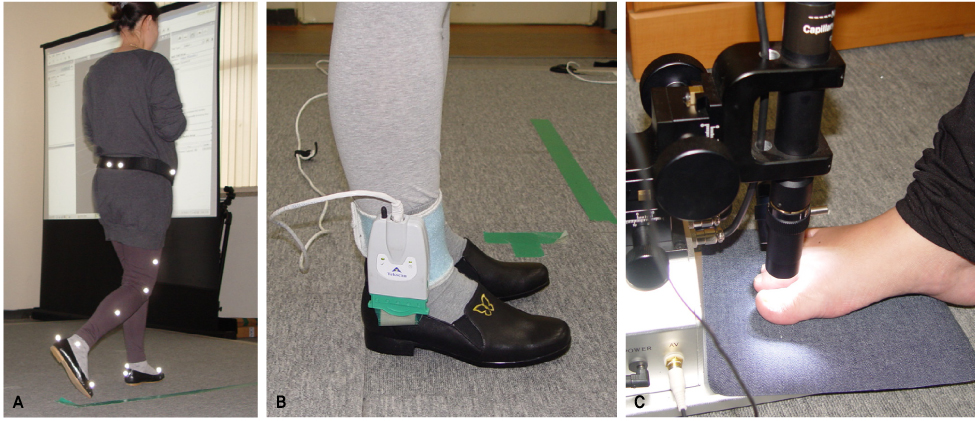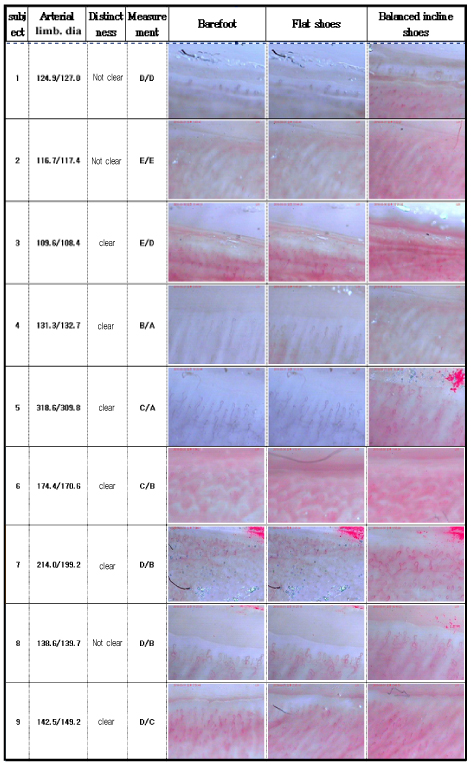Korean J Obstet Gynecol.
2010 Nov;53(11):988-997. 10.5468/kjog.2010.53.11.988.
The effect of balanced incline shoes on walking and feet for the pregnant women
- Affiliations
-
- 1Department of Obstetrics and Gynecology, The Catholic University of Korea College of Medicine, Seoul, Korea. janghkim@catholic.ac.kr
- 2Korean Association of Obstetricians and Gynecologists, Seoul, Korea.
- 3Department of Public Health, Yonsei University College of Medicine, Seoul, Korea.
- 4Department of Beauty Design, Tongwon College, Gwangju, Korea.
- 5Korea Institute of Footwear & Leather Technology, Busan, Korea.
- KMID: 1836713
- DOI: http://doi.org/10.5468/kjog.2010.53.11.988
Abstract
OBJECTIVE
This study investigated the effects of the balanced incline shoes on the stabilized walking, fatigue reduction, improvement of blood circulation and prevention of foot related disease for the pregnant women.
METHODS
The seven 7~9 month pregnant women and three maternities within 3 months after delivery without a history of disease performed the cycles for each of the two walking conditions: wearing balanced incline shoes and flat shoes. The differences between the two walking conditions were statistically investigated including three dimensional motion analysis, footprint pressures and blood flow. To find out any possible difference between these two kinds and among the subjects, the statistical tool was utilized with one-way layout design.
RESULTS
Of 10 subjects, seven subjects showed the significantly decreased in distance of both knee with balanced incline shoes than flat shoes (P<0.05). Those with the balanced incline shoes had a walking pattern whose knee moved inward about 6 mm, compared to those with the flat regular ones. Over plantar pressure measurements for all ten, it also revealed statistically significant differences that the balanced incline shoes decreased its pressure 15% and that the pressure heavily on heel area was distributed outward along the arch (P<0.05). The blood stream velocity belonged to C (200~300 microm/sec) or D (100~200 microm/sec) for the nine before wearing the balanced incline shoes. However, it was found to be enhanced in A (>600 microm/sec) or B (400~600 microm/sec) after they put them on, indicating 1~2 part equivalent improvement. The blood stream velocity showed a incremental tendency after wearing balanced incline shoes.
CONCLUSION
This result suggests that the balanced incline shoes corrected the postures, stabilized the gait pattern, decreased the excessive load on ankle plantar flexors, reduced the fatigue level and improved the blood circulation.
Keyword
MeSH Terms
Figure
Reference
-
1. Ansari NN, Hasson S, Naghdi S, Keyhani S, Jalaie S. Low back pain during pregnancy in Iranian women: Prevalence and risk factors. Physiother Theory Pract. 2010. 26:40–48.
Article2. Foti T, Davids JR, Bagley A. A biomechanical analysis of gait during pregnancy. J Bone Joint Surg Am. 2000. 82:625–632.
Article3. Dunning K, Lemasters G, Bhattacharya A. A major public health issue: the high incidence of falls during pregnancy. Matern Child Health J. 2010. 14:720–725.
Article4. Salathe EP Jr, Arangio GA, Salathe EP. A biomechanical model of the foot. J Biomech. 1986. 19:989–1001.5. Alexander IJ. The Foot: Examination & Diagnosis. 1997. 2nd ed. New York: Churchill Livingstone.6. Perry J. Gait analysis: Normal and pathological function. 1992. Thorofare: SLACK.7. Tsung BY, Zhang M, Mak AF, Wong MW. Effectiveness of insoles on plantar pressure redistribution. J Rehabil Res Dev. 2004. 41:767–774.
Article8. Kwon SH, Kim CS, Kim HJ, Ryu TB, Chung MK. The effect of a wedged rocker sole on ankle joints during gait. J Ergon Soc Korea. 2008. 27:93–101.9. Shepherd RJ. Physical activity and aging. 1987. 2nd ed. Rockville: Aspen Publishers.10. Porcari JP, Ebbeling CB, Ward A, Freedson PS, Rippe JM. Walking for exercise testing and training. Sports Med. 1989. 8:189–200.
Article11. Radin EL, Parker HG, Pugh JW, Steinberg RS, Paul IL, Rose RM. Response of joints to impact loading 3 Relationship between trabecular microfractures and cartilage degeneration. J Biomech. 1973. 6:51–57.12. Nigg BM, Liu W. The effect of muscle stiffness and damping on simulated impact force peaks during running. J Biomech. 1999. 32:849–856.
Article13. Serink MT, Nachemson A, Hansson G. The effect of impact loading on rabbit knee joints. Acta Orthop Scand. 1977. 48:250–262.
Article14. Wang SM, Dezinno P, Maranets I, Berman MR, Caldwell-Andrews AA, Kain ZN. Low back pain during pregnancy: prevalence, risk factors, and outcomes. Obstet Gynecol. 2004. 104:65–70.15. Blake RL, Denton JA. Functional foot orthoses for athletic injuries. A retrospective study. J Am Podiatr Med Assoc. 1985. 75:359–362.
Article16. Smith LS, Clarke TE, Hamill CL, Santopietro F. The effects of soft and semi-rigid orthoses upon rearfoot movement in running. J Am Podiatr Med Assoc. 1986. 76:227–233.
Article17. Keating EM, Faris PM, Ritter MA, Kane J. Use of lateral heel and sole wedges in the treatment of medial osteoarthritis of the knee. Orthop Rev. 1993. 22:921–924.18. Tohyama H, Yasuda K, Kaneda K. Treatment of osteoarthritis of the knee with heel wedges. Int Orthop. 1991. 15:31–33.
Article19. Yasuda K, Sasaki T. The mechanics of treatment of the osteoarthritic knee with a wedged insole. Clin Orthop Relat Res. 1987. (215):162–172.
Article20. Tochigi Y. Effect of arch supports on ankle-subtalar complex instability: a biomechanical experimental study. Foot Ankle Int. 2003. 24:634–639.
Article21. Fujita Y, Uechi M, Uehara C, Kawai N, Suzuki M, Ninomiya H. Influence of heel height on gait during pregnancy and features the pregnant women's gait. Rigakuryoho Kagaku. 2006. 21:287–291.
Article22. Hansen AH, Childress DS. Effects of shoe heel height on biologic rollover characteristics during walking. J Rehabil Res Dev. 2004. 41:547–554.
Article
- Full Text Links
- Actions
-
Cited
- CITED
-
- Close
- Share
- Similar articles
-
- The Effect of Ballet Shoes on Plantar Foot during Ambulation
- Change of In-Shoe Plantar Pressure According to Types of Shoes (Flat Shoes, Running Shoes, and High Heels)
- The Effects of Shoes Modification on Energy Consumption in Hemiplegic Gait
- Effects of Asymmetrical Weight Bearing during Straight and Circular Walking in Hemiplegic Patients
- The Changes of Foot Breadth and Ball Girth According to the Height of Shoes Heel





